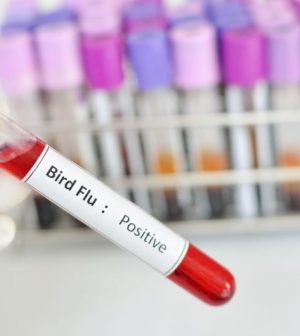- Navigating Your Midlife Crisis: Embracing New Possibilities
- City Raccoons Showing Signs of Domestication
- Mapping the Exposome: Science Broadens Focus to Environmental Disease Triggers
- One Week Less on Social Media Linked to Better Mental Health
- Your Brain Changes in Stages as You Age, Study Finds
- Some Suicide Victims Show No Typical Warning Signs, Study Finds
- ByHeart Formula Faces Lawsuits After Babies Sickened With Botulism
- Switch to Vegan Diet Could Cut Your Greenhouse Gas Emissions in Half
- Regular Bedtime Does Wonders for Blood Pressure
- Dining Alone Could Mean Worse Nutrition for Seniors
Doctors Describe Texas Dairy Farm Worker’s Case of Bird Flu

Doctors in Texas are describing the only known human case of H5N1 avian flu connected to the ongoing outbreak of the disease in dairy cows.
Bird flu in humans remains extremely rare, but in the hundreds of cases documented worldwide over the past few years, about half proved fatal — upping scientists’ concerns about the possibility that an easily transmitted human bird flu might one day emerge.
The unidentified Texas man, a dairy farm worker, appears to have been lucky: His case of H5N1 amounted to little more than a case of conjunctivitis, an inflammatory “pinkeye” that resolved after antibiotic treatment.
A team led by Dr. Timothy Uyeki of the U.S. Centers for Disease Control and Atlanta and Dr. Scott Milton of the Texas Department of State Health Services described the case in a report published May 3 in the New England Journal of Medicine.
“In late March 2024, an adult dairy farm worker had onset of redness and discomfort in the right eye,” they wrote.
Upon examination, they diagnosed what looked like a normal case of conjunctivitis — bloodshot and painful eyes but with no effect on the man’s vision.
Other than that, his “vital signs were unremarkable,” the team said, with no respiratory symptoms, clear lungs and a normal blood-oxygen level.
However, “the worker reported no contact with sick or dead wild birds, poultry, or other animals but reported direct and close exposure to dairy cows that appeared to be well and with sick cows that showed the same signs of illness as cows at other dairy farms in the same area of northern Texas with confirmed HPAI A(H5N1) virus infection,” the researchers said. “The worker reported wearing gloves when working with cows but did not use any respiratory or eye protection.”
Swabs were taken of his eyes and nasal passages, and they tested positive for flu. Further testing narrowed that diagnosis down to H5N1.
The man’s condition didn’t worsen, but he was given a standard antiviral medication, oseltamivir, twice daily for five days, and was told to isolate at home. People living in his home were also given the antiviral to protect them from H5N1.
“Over the subsequent days, the worker reported resolution of conjunctivitis without respiratory symptoms, and household contacts remained well,” the team wrote.
Close laboratory inspection of the strain implicated in the man’s infection reveal a key viral mutation, called PB2 E627K. This mutation “has been associated with viral adaptation to mammalian hosts and detected previously in humans and other mammals infected with HPAI A(H5N1) viruses,” the researchers noted.
They added that the man’s H5N1 strain showed no evidence of mutations that might make it any less responsive to treatment with standard antivirals recommended against influenza.
And there was good news for scientists developing avian influenza vaccines, should they become necessary: Specific vaccine-sensitive components of the strain of H5N1 that infected the dairy worker are “closely related” to viruses already being studied by bird flu vaccine researchers.
“Because influenza A(H5N1) viruses have pandemic potential, these candidate vaccine viruses are available to manufacturers and could be used to produce vaccine if needed,” the researchers noted.
The latest data on the outbreak of bird flu among U.S. dairy cows has detected infection in 36 herds across nine states. Tests conducted by federal health officials have found evidence of inactive DNA “fragments” of H5N1 in about 1 in 20 samples of milk, but no live virus — it is thought that pasteurization kills the virus. Tests of ground beef have also turned up negative for the virus.
More information
Find out more about H5N1 avian flu at the CDC.
SOURCE: New England Journal of Medicine, May 3, 2024
Source: HealthDay
Copyright © 2025 HealthDay. All rights reserved.










